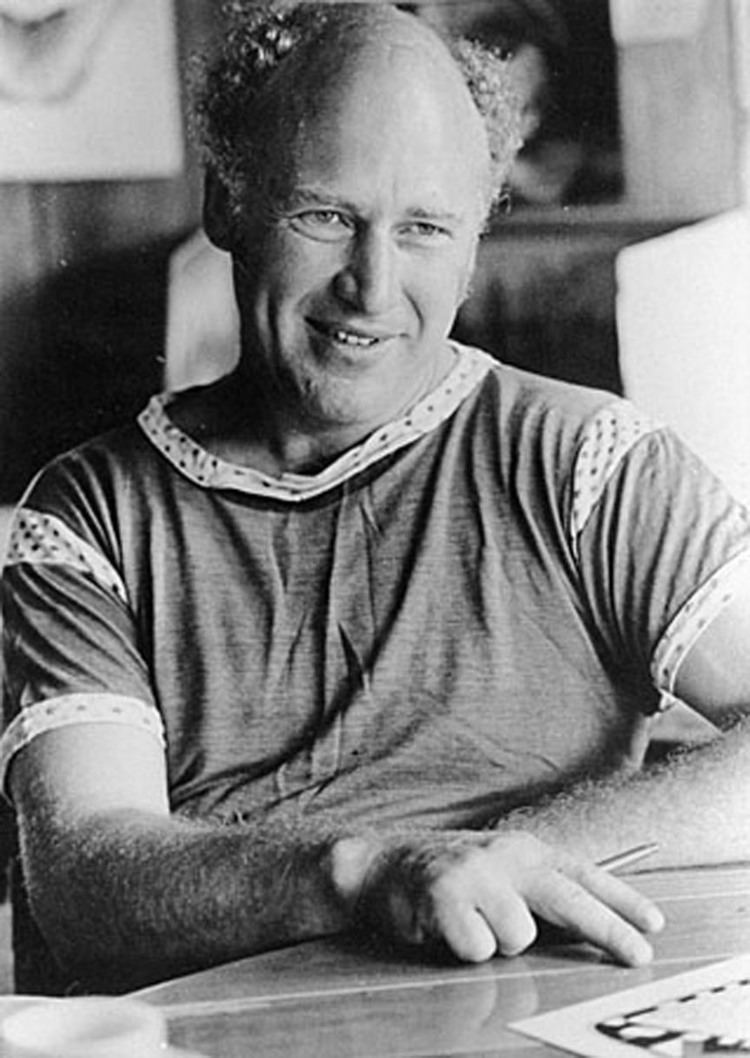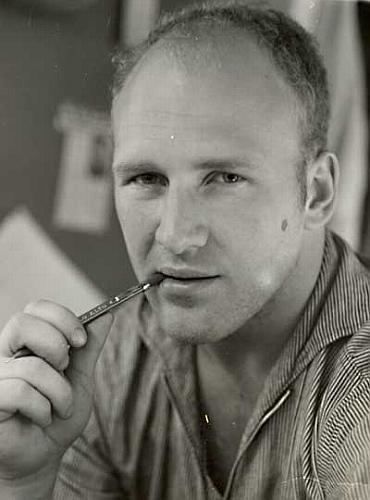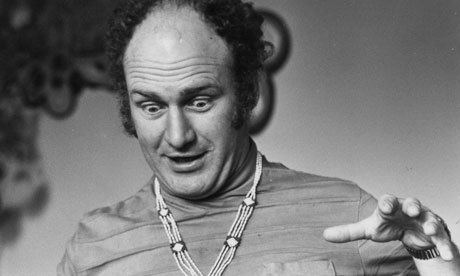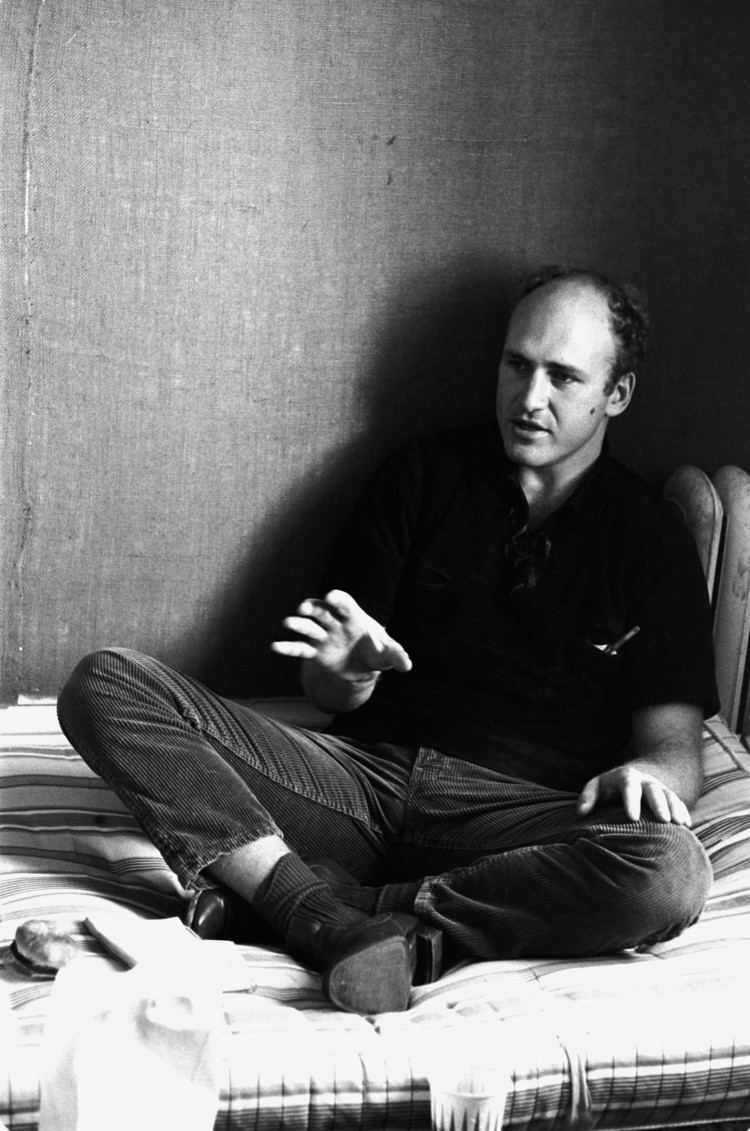Nationality American Role Novelist | Name Ken Kesey Genre Beat, postmodernism | |
 | ||
Born Kenneth Elton KeseySeptember 17, 1935La Junta, Colorado, U.S. ( 1935-09-17 ) Occupation Novelist, short story writer, essayist, poet Books One Flew Over the Cuckoo's, Sometimes a Great Notion, Sailor Song, Demon Box, The Further inquiry Similar People | ||
Ken kesey live at university of virginia
Kenneth Elton "Ken" Kesey (; September 17, 1935 – November 10, 2001) was an American novelist, essayist, and countercultural figure. He considered himself a link between the Beat Generation of the 1950s and the hippies of the 1960s.
Contents
- Ken kesey live at university of virginia
- Ken Kesey interview on One Flew Over the Cuckoos Nest 1992
- Early life
- Experimentation with psychoactive drugs
- One Flew Over the Cuckoos Nest
- Merry Pranksters
- Death of son
- Final years
- Death
- Legacy
- Works
- References

Kesey was born in La Junta, Colorado and grew up in Springfield, Oregon, graduating from the University of Oregon in 1957. He began writing One Flew Over the Cuckoo's Nest in 1960 following the completion of a graduate fellowship in creative writing at Stanford University; the novel was an immediate commercial and critical success when published two years later. Subsequently, he moved to nearby La Honda, California and began hosting happenings with former colleagues from Stanford, miscellaneous bohemian and literary figures (most notably Neal Cassady), and other friends under the imprimateur of the Merry Pranksters; these parties, known as Acid Tests, integrated the consumption of LSD with multimedia performances. He mentored the Grateful Dead (the de facto "house band" of the Acid Tests) throughout their incipience and continued to exert a profound influence upon the group throughout their long career. Sometimes a Great Notion—an epic account of the vicissitudes of an Oregon logging family that aspired to the modernist grandeur of William Faulkner's Yoknapatawpha saga—was a commercial success that polarized critics and readers upon its release in 1964, although Kesey regarded the novel as his magnum opus.

In 1965, following an arrest for marijuana possession and subsequent faked suicide, Kesey was imprisoned for five months. Shortly thereafter, he returned home to the Willamette Valley and settled in Pleasant Hill, Oregon, where he maintained a secluded, family-oriented lifestyle for the rest of his life. In addition to teaching at the University of Oregon—an experience that culminated in Caverns (1989), a collaborative novel written by Kesey and his graduate workshop students under the pseudonym of "O.U. Levon"—he continued to regularly contribute fiction and reportage to such publications as Esquire, Rolling Stone, Oui, Running, and The Whole Earth Catalog; various iterations of these pieces were collected in Kesey's Garage Sale (1973) and Demon Box (1986).

Between 1974 and 1980, Kesey published six issues of Spit in the Ocean, a little magazine that featured excerpts from an unfinished novel (Seven Prayers by Grandma Whittier, an account of Kesey's grandmother's struggle with Alzheimer's disease) and contributions from such luminaries as Margo St. James, Kate Millett, Stewart Brand, Saul-Paul Sirag, Jack Sarfatti, Paul Krassner, and William S. Burroughs. After a third novel (Sailor Song) was released to lukewarm reviews in 1992, he reunited with the Merry Pranksters and began publishing works on the Internet until ill health (including a stroke) curtailed his activities.

Ken Kesey interview on "One Flew Over the Cuckoo's Nest" (1992)
Early life
Ken Kesey was born in La Junta, Colorado, to dairy farmers Geneva (née Smith) and Frederick A. Kesey. In 1946, the family moved to Springfield, Oregon. Kesey was a champion wrestler in both high school and college in the 174-pound weight division, and he almost qualified to be on the Olympic team until a serious shoulder injury stopped his wrestling career. He graduated from Springfield High School in 1953. An avid reader and filmgoer, the young Kesey took John Wayne, Edgar Rice Burroughs, and Zane Grey as his role models (later naming a son Zane) and toyed with magic, ventriloquism, and hypnotism.
In 1956, while attending the University of Oregon School of Journalism and Communication in neighboring Eugene, Oregon, Kesey eloped with his high-school sweetheart, Norma "Faye" Haxby, whom he had met in seventh grade. According to Kesey, "Without Faye, I would have been swept overboard by notoriety and weird, dope-fueled ideas and flower-child girls with beamy eyes and bulbous breasts." Married until his death at the age of 66, they had three children: Jed, Zane, and Shannon. Additionally, with the approval of Faye Kesey, Ken fathered a daughter, Sunshine Kesey, with fellow Merry Prankster Carolyn "Mountain Girl" Adams. Born in 1966, Sunshine was raised by Adams and her stepfather, Jerry Garcia.
Kesey had a football scholarship for his freshman year, but switched to University of Oregon wrestling team as a better fit to his build. After posting a .885 winning percentage in the 1956–57 season, he received the Fred Low Scholarship for outstanding Northwest wrestler. In 1957, Kesey was second in his weight class at the Pacific Coast intercollegiate competition. He remains "ranked in the top 10 of Oregon Wrestling’s all time winning percentage."
A member of Beta Theta Pi throughout his studies, Kesey graduated from the University of Oregon with a B.A. in speech and communication in 1957. Increasingly disengaged by the playwriting and screenwriting courses that comprised much of his major, he began to take literature classes in the second half of his collegiate career with James B. Hall, a cosmopolitan alumnus of the Iowa Writers' Workshop who had previously taught at Cornell University and later served as provost of College V at the University of California, Santa Cruz. Hall took on Kesey as his protege and cultivated his interest in literary fiction, introducing Kesey (whose reading interests were hitherto confined to science fiction) to the works of Ernest Hemingway and other paragons of literary modernism. After the last of several brief summer sojourns as a struggling actor in Los Angeles, he published his first short story ("First Sunday of September") in the Northwest Review and successfully applied to the highly selective Woodrow Wilson National Fellowship for the 1958–59 academic year.
Unbeknownst to Kesey, who applied at Hall's request, the maverick literary critic Leslie Fiedler (then based at the University of Montana) successfully importuned the regional fellowship committee to select the "rough-hewn" Kesey alongside more traditional fellows from Reed College and other elite institutions. Because he lacked the prerequisites to work toward a traditional master's degree in English as a communications major, Kesey elected to enroll in the non-degree program at Stanford University's Creative Writing Center that fall. While studying and working in the Stanford milieu over the next five years, most of them spent as a resident of Perry Lane (a historically bohemian enclave adjacent to the university golf course), he developed intimate lifelong friendships with fellow writers Ken Babbs, Larry McMurtry, Wendell Berry, Ed McClanahan, Gurney Norman, and Robert Stone.
During his initial fellowship year, Kesey frequently clashed with Center director Wallace Stegner, who regarded the young writer as "a sort of highly talented illiterate" and rejected Kesey's application for a departmental Stegner Fellowship before permitting his attendance as a Woodrow Wilson Fellow. Reinforcing these perceptions, Stegner's deputy Richard Scowcroft later recalled that "neither Wally nor I thought he had a particularly important talent." According to Stone, Stegner "saw Kesey... as a threat to civilization and intellectualism and sobriety" and continued to reject Kesey's Stegner Fellowship applications for the 1959–60 and 1960–61 terms.
Nevertheless, Kesey received the prestigious $2,000 Harper-Saxton Prize for his first novel in progress (the oft-rejected Zoo) and audited the graduate writing seminar—a courtesy nominally accorded to former Stegner Fellows, although Kesey only secured his place by falsely claiming to Scowcroft that his colleague (on sabbatical through 1960) "had said that he could attend classes for free"—through the 1960-61 term. The course was initially taught that year by Viking Press editorial consultant and Lost Generation eminence grise Malcolm Cowley, who was "always glad to see" Kesey and fellow auditor Tillie Olsen. Cowley was succeeded the following quarter by the Irish short story specialist Frank O'Connor; frequent spats between O'Connor and Kesey ultimately precipitated his departure from the class. While under the tutelage of Cowley, he began to draft and workshop the manuscript that would evolve into One Flew Over the Cuckoo's Nest.
Reflecting upon this period in a 1999 interview with Robert K. Elder, Kesey recalled, "I was too young to be a beatnik, and too old to be a hippie."
Experimentation with psychoactive drugs
At the instigation of Perry Lane neighbor and Stanford psychology graduate student Vik Lovell, an acquaintance of Richard Alpert and Allen Ginsberg, Kesey volunteered to take part in what turned out to be a CIA-financed study under the aegis of Project MKULTRA, a highly secret military program, at the Menlo Park Veterans' Hospital where he worked as a night aide. The project studied the effects of psychoactive drugs, particularly LSD, psilocybin, mescaline, cocaine, aMT, and DMT on people. Kesey wrote many detailed accounts of his experiences with these drugs, both during the study and in the years of private experimentation that followed.
Kesey's role as a medical guinea pig, as well as his stint working at the Veterans' Administration hospital, inspired him to write One Flew Over the Cuckoo's Nest. The success of this book, as well as the demolition of the Perry Lane cabins in August 1963, allowed him to move to a log house at 7940 La Honda Road in La Honda, California, a rustic hamlet in the Santa Cruz Mountains fifteen miles to the west of the Stanford University campus. He frequently entertained friends and many others with parties he called "Acid Tests," involving music (including the Stanford-educated Anonymous Artists of America and Kesey's favorite band, the Grateful Dead), black lights, fluorescent paint, strobe lights, LSD, and other psychedelic effects. These parties were described in some of Ginsberg's poems and served as the basis for Tom Wolfe's The Electric Kool-Aid Acid Test, an early exemplar of the nonfiction novel. Other firsthand accounts of the Acid Tests appear in Hell's Angels: The Strange and Terrible Saga of the Outlaw Motorcycle Gangs by Hunter S. Thompson and the 1967 Hell's Angels memoir Freewheelin Frank, Secretary of the Hell's Angels (Frank Reynolds; ghostwritten by Michael McClure).
One Flew Over the Cuckoo's Nest
While still enrolled at the University of Oregon in 1957, Kesey wrote End of Autumn; according to Rick Dogson, the novel "focused on the exploitation of college athletes by telling the tale of a football lineman who was having second thoughts about the game." Although Kesey came to regard the unpublished work as juvenilia, an excerpt served as his Stanford Creative Writing Center application sample.
During his Woodrow Wilson Fellowship year, Kesey wrote Zoo, a novel about the beatniks living in the North Beach community of San Francisco, but it was never published.
The inspiration for One Flew Over the Cuckoo's Nest came while working on the night shift with Gordon Lish at the Menlo Park Veterans' Hospital. There, Kesey often spent time talking to the patients, sometimes under the influence of the hallucinogenic drugs with which he had volunteered to experiment. Kesey did not believe that these patients were insane, but rather that society had pushed them out because they did not fit the conventional ideas of how people were supposed to act and behave. Published under the guidance of Cowley in 1962, the novel was an immediate success; in 1963, it was adapted into a successful stage play by Dale Wasserman, and in 1975, Miloš Forman directed a screen adaptation, which won the "Big Five" Academy Awards: Best Picture, Best Actor (Jack Nicholson), Best Actress (Louise Fletcher), Best Director (Forman) and Best Adapted Screenplay (Lawrence Hauben, Bo Goldman).
Kesey originally was involved in creating the film, but left two weeks into production. He claimed never to have seen the movie because of a dispute over the $20,000 he was initially paid for the film rights. Kesey loathed the fact that, unlike the book, the film was not narrated by the Chief Bromden character, and he disagreed with Jack Nicholson's being cast as Randle McMurphy (he wanted Gene Hackman). Despite this, Faye Kesey has stated that her husband was generally supportive of the film and pleased that it was made.
Merry Pranksters
When the publication of his second novel, Sometimes a Great Notion in 1964, required his presence in New York, Kesey, Neal Cassady, and others in a group of friends they called the Merry Pranksters took a cross-country trip in a school bus nicknamed Further. This trip, described in The Electric Kool-Aid Acid Test (and later in Kesey's unproduced screenplay, The Further Inquiry) was the group's attempt to create art out of everyday life, and to experience roadway America while high on LSD. In an interview after arriving in New York, Kesey is quoted as saying, "The sense of communication in this country has damn near atrophied. But we found as we went along it got easier to make contact with people. If people could just understand it is possible to be different without being a threat." A huge amount of footage was filmed on 16mm cameras during the trip which remained largely unseen until the release of Alex Gibney's Magic Trip in 2011.
After the bus trip, the Pranksters threw parties they called Acid Tests around the San Francisco Bay Area from 1965 to 1966. Many of the Pranksters lived at Kesey's residence in La Honda. In New York, Cassady introduced Kesey to Jack Kerouac and Allen Ginsberg, who then turned them on to Timothy Leary. Sometimes a Great Notion inspired a 1970 film starring and directed by Paul Newman; it was nominated for two Academy Awards, and in 1972 was the first film shown by the new television network HBO, in Wilkes-Barre, Pennsylvania.
Kesey was arrested in La Honda, California, for possession of marijuana in 1965. In an attempt to mislead police, he faked suicide by having friends leave his truck on a cliffside road near Eureka, along with an elaborate suicide note, written by the Pranksters. Kesey fled to Mexico in the back of a friend's car. He returned to the United States eight months later. On January 17, 1966, Kesey was sentenced to six months to be served at the San Mateo County jail in Redwood City, California. Two nights later, he was arrested again, this time with Carolyn Adams, while smoking marijuana on the rooftop of Stewart Brand's Telegraph Hill home in San Francisco. While serving his sentence, he was introduced to a highly recommended San Francisco lawyer, Richard Potack, who specialized in marijuana cultivation. On his release, he moved back to the family farm in Pleasant Hill, Oregon, in the Willamette Valley, where he spent the rest of his life. He wrote many articles, books (mostly collections of his articles), and short stories during that time.
Death of son
In 1984, Kesey's 20-year-old son Jed, a wrestler for the University of Oregon, suffered severe head injuries on the way to a tournament when the team's van crashed after sliding off the highway; two days after he was declared brain-dead, his parents gave permission for his organs to be donated.
Jed's death deeply affected Kesey, who later called Jed a victim of policies that had starved the team of funding. He wrote to Senator Mark Hatfield, "And I began to get mad, Senator. I had finally found where the blame must be laid: that the money we are spending for national defense is not defending us from the villains real and near, the awful villains of ignorance, and cancer, and heart disease and highway death. How many school buses could be outfitted with seatbelts with the money spent for one of those 16-inch shells?"
At a Grateful Dead concert soon after the death of promoter Bill Graham, Kesey delivered a eulogy, mentioning that Graham had donated $1,000 toward a memorial to Jed atop Mount Pisgah, near the Kesey home in Pleasant Hill. Ken Kesey donated $33,395 towards the purchase of a proper bus for the school's wrestling team to replace the chicken van that fell off a cliff.
Final years
Kesey was diagnosed with diabetes in 1992. In 1994, he toured with members of the Merry Pranksters performing a musical play he wrote about the millennium called Twister: A Ritual Reality. Many old and new friends and family showed up to support the Pranksters on this tour that took them from Seattle's Bumbershoot, all along the West Coast including a sold out two-night run at The Fillmore in San Francisco to Boulder, Colorado, where they coaxed (or pranked) the Beat Generation poet Allen Ginsberg into performing with them.
Kesey mainly kept to his home life in Pleasant Hill, preferring to make artistic contributions on the Internet or holding ritualistic revivals in the spirit of the Acid Test. In the official Grateful Dead DVD release The Closing of Winterland (2003) documenting the monumental New Year's 1978/1979 concert at the Winterland Arena in San Francisco, Kesey is featured in a between-set interview.
On August 14, 1997, Kesey and his Pranksters attended a Phish concert in Darien Lake, New York. Kesey and the Pranksters appeared onstage with the band and performed a dance-trance-jam session involving several characters from The Wizard of Oz and Frankenstein.
In June 2001, Kesey was invited and accepted as the keynote speaker at the annual commencement of The Evergreen State College. His last major work was an essay for Rolling Stone magazine calling for peace in the aftermath of the September 11 attacks.
Death
In 1998, health problems began to weaken Kesey, starting with a stroke that year. On October 25, 2001 Kesey had surgery on his liver to remove a tumor. He did not recover from that operation and died of complications on November 10, 2001, age 66.
Legacy
The film Gerry (2002) is dedicated to the memory of Ken Kesey.
Works
Some of Kesey's better-known works include:
